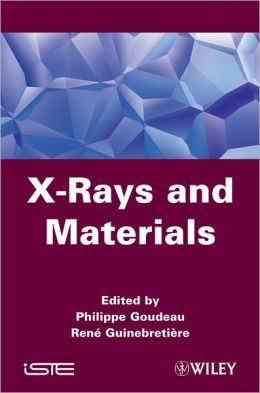 [内容简介]
[内容简介]
This book presents reviews of various aspects of radiation/matter interactions, be these instrumental developments, the application of the study of the interaction of X-rays and materials to a particular scientific field, or specific methodological approaches.
The overall aim of the book is to provide reference summaries for a range of specific subject areas within a pedagogical framework. Each chapter is written by an author who is well known within their field and who has delivered an invited lecture on their subject area as part of the “RX2009 – X-rays and Materials” colloquium that took place in December 2009 at Orsay in France.
The book consists of five chapters on the subject of X-ray diffraction, scattering and absorption.
Chapter 1 gives a detailed presentation of the capabilities and potential of beam lines dedicated to condensed matter studies at the SOLEIL synchrotron radiation source.
Chapter 2 focuses on the study of nanoparticles using small-angle X-ray scattering.
Chapter 3 discusses the quantitative studies of this scattering signal used to analyze these characteristics in detail.
Chapter 4 discusses relaxor materials, which are ceramics with a particularly complex microstructure. Chapter 5 discusses an approach enabling the in situ analysis of these phase transitions and their associated microstructural changes.
[目录]|
Preface xi
Chapter 1 Synchrotron Radiation: Instrumentation in Condensed Matter Jean-Paul Itie François Baudelet Valéries Briois Eric Elkaïm Amor Nadji Dominique Thiaudière 1
1.1 Introduction 1
1.2 Light sources in the storage ring 2
1.2.1 Bending magnets 2
1.2.2 Insertion devices 4
1.2.2.1 Wigglers 4
1.2.2.2 Undulators 5
1.3 Emittance and brilliance of a source 6
1.4 X-ray diffraction with synchrotron radiation 8
1.4.1 Angle-dispersive diffraction 8
1.4.2 Energy dispersive diffraction 9
1.5 X-ray absorption spectroscopy using synchrotron radiation 13
1.5.1 X-ray absorption spectroscopy 14
1.5.2 Energy-scanned X-ray absorption spectroscopy 17
1.5.3 Energy dispersive X-ray absorption spectroscopy 18
1.6 SAMBA: the X-ray absorption spectroscopy beam line of SOLEIL for 4-40 keV 20
1.7 The DIFFABS bean line 27
1.7.1 Description of the beam line 27
1.7.2 Examples of use of the DIFFABS beam line 31
1.8 CRISTAL beam line 34
1.8.1 Beam line optics 35
1.8.2 Diffractometers 35
1.8.3 Sample environments 36
1.9 The SOLEIL ODE line for dispersive EXAFS 38
1.9.1 Optics of the ODE line 38
1.9.2 Magnetic circular dischroism 39
1.9.3 X-ray absorption spectroscopy under extreme pressure and/or temperature conditions 41
1.10 Conclusion 43
1.11 Bibliography 44
Chapter 2 Nanoparticle Characterization using Central X-ray Diffraction Olivier Spalla 49
2.1 Introduction 49
2.2 Definition of scattered intensity 50
2.3 Invariance principle 52
2.3.1 General case 52
2.3.2 Isotropic systems 53
2.3.3 Multi-level systems 54
2.4 Behavior for large q: the Porod regime 55
2.5 Particle-based systems 59
2.5.1 Definition of form factor 59
2.5.2 Introduction to the structure factor 61
2.5.3 Intensity behavior at small q: the Guinier regime 64
2.5.4 Volume measurements 65
2.5.5 Some well-known form factors 66
2.5.6 Polyhedral particles 70
2.5.6.1 Form factor of a polyhedron 70
2.5.6.2 Comparison between different polyhedra with cylindrical and spherical forms 73
2.6 An absolute scale for measuring particle numbers 75
2.7 Conclusion 78
2.8 Bibliography 79
Chapter 3 X-ray Diffraction for Structural Studies of Carbon Nanotubes and their Insertion Compounds Julien Cambedouzou Pascale Launois 81
3.1 Introduction 81
3.1.1 Introduction to carbon nanotubes 82
3.1.2 Uses of X-ray scattering for studies of carbon nanotubes 84
3.2 Single-walled carbon nanotubes 85
3.2.1 Calculation of a powder diffraction diagram 86
3.2.1.1 Individual nanotubes 86
3.2.1.2 Bundle structure 89
3.2.1.3 Inclusion of a distribution of nanotube diameters 91
3.2.1.4 Effects of nanotube length 93
3.2.2 Analysis of experimental scattering diagrams 94
3.3 Multi-walled carbon nanotubes 96
3.3.1 Calculation of powder diffraction diagrams for a powder of individual multi-walled nanotubes 97
3.3.2 Analysis of an experimental diffraction diagram 101
3.4 Hybrid nanotubes 102
3.4.1 Peapods 102
3.4.2 Ion insertion into nanotubes 108
3.5 Textured powder samples 110
3.5.1 Quantification of nanotube orientation 112
3.5.2 Separation of diffraction components in hybrid nanotubes 116
3.6 Conclusion 121
3.7 Bibliography 122
Chapter 4 Dielectric Relaxation and Morphotropic Phases in Nanomaterials Jean-Michel Kiat 129
4.1 Introduction 129
4.2 Dielectric relaxation and morphotropic region: definition and mechanism 130
4.2.1 Definition of a relaxor compound 130
4.2.2 Microscopic mechanism associated with the occurrence of dielectric relaxation 134
4.2.2.1 Microscopic mechanism: high temperatures (regimes where T> TB and then T* >T >TB 135
4.2.2.2 Microscopic mechanism: intermediate temperatures (regimes where TG >T >T*) 141
4.2.2.3 Microscopic mechanism (regime where T >TG) 143
4.2.2.4 Microscopic mechanism: importance of local chemistry 145
4.2.3 Generalization of mechanism: ferroelectric relaxors 148
4.2.4 Definition of a compound and a morphotropic region 152
4.3 Relaxation, morphotropic region and size reduction 163
4.3.1 Size reduction in relaxor ceramics 163
4.3.2 Size reduction in MPB ceramics 168
4.3.3 Thin layers and super-lattices 170
4.4 Conclusion 174
4.5 Acknowledgements 175
4.6 Bibliography 175
Chapter 5 Evolution of Solid-state Microstructures in Polycrystalline Materials: Application of High-energy X-ray Diffraction to Kinetic and Phase Evolution Studies Elisabeth Aeby-Gautier Guillaume Greandier Moukrane Dehmas Fabien Bruneseaux Adeline Beneteau Patrick Weisbecker Benoît Appolaire Sabine Denis 181
5.1 Introduction 181
5.2 Experimental methods 183
5.2.1 Apparatus for thermo-mechanical studies 185
5.2.2 Choice of detector 188
5.2.3 Device calibration 191
5.2.4 Data analysis 192
5.3 Results 195
5.3.1 Phase transformation in titanium alloy Ti-17 195
5.3.2 Martensitic transformation of a maraging steel 208
5.4 Conclusion 213
5.5 Acknowledgements 214
5.6 Bibliography 214
List of Authors 221
Index 223

 新书报道
新书报道